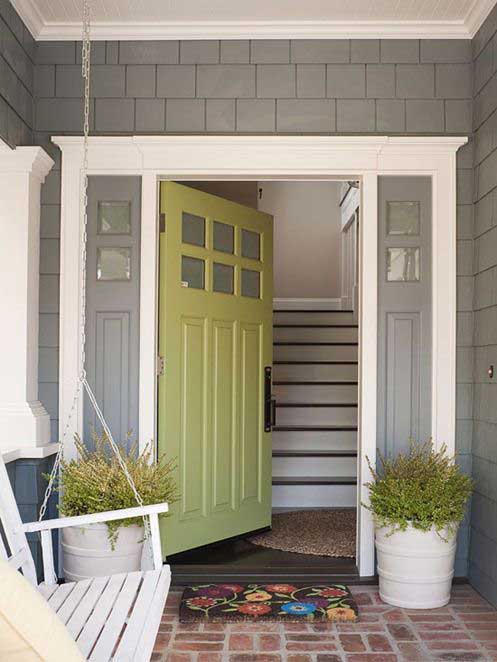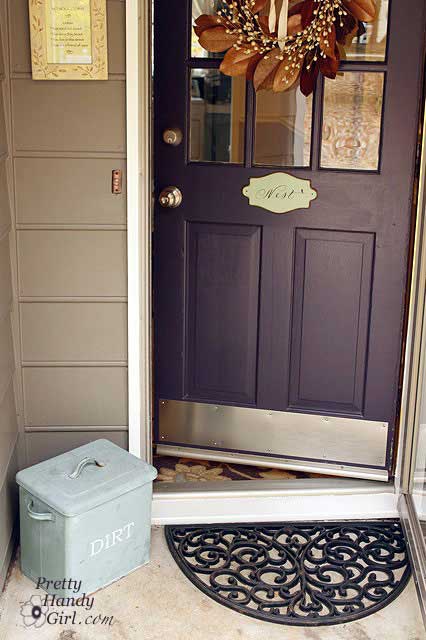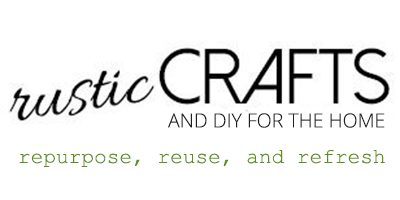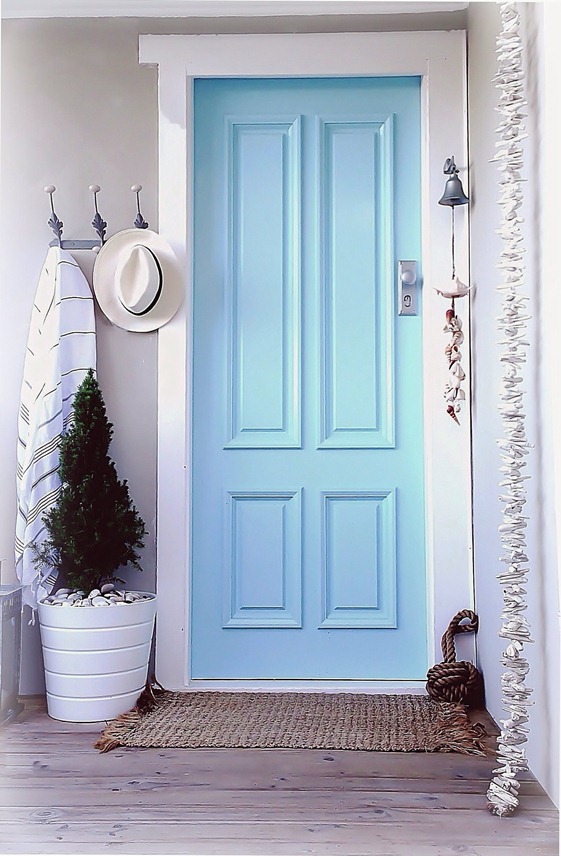Today’s featured post is written by Jay Harris from Home Depot. I think you will enjoy what he has to say about front doors and the colors that you choose!
A Colorful Front for Your Rustic Home
When most people think of rustic design, their minds immediately turn to bare wood and other natural finishes as well as brown and green hues. But ‘rustic’ doesn’t necessarily mean ‘raw,’ and opting for a cottage style doesn’t have to limit your colors to a woodsy palette.
Our homes are a reflection of our personalities, and favorite shades should be front and center, even if you’ve got an affinity for shabby chic décor or tend towards natural notes. And the best place to display your top tints? The front door. Below are a handful of ideas for infusing character and color into the exterior of your rustic charmer.
Red Doors

If you welcome life with a certain joie de vivre, then a vivid red is the perfect blush for your home’s welcoming statement. An apple-toned front door symbolizes health, vitality, and strength and is often selected by those who are outgoing and optimistic. Try using this pop of pretty color to accent the bold lines of a craftsman-style residence. (See “analogous” below.)
Yellow Doors
With its sunny sensation of happiness, yellow warms any entrance with a feeling of imagination and whimsy. Trusted by friendly folks with good humor and high spirits, this joyful shade is ideal for a warm social center such as a bungalow.
Green Doors

The color of growth and prosperity, green conveys a sense of renewal and harmony. Preferred by gentle, community-minded people, this peaceful color nicely accents the warm wood of a cabin. (See “complementary” below.)
Blue Doors
photo via abeachcottage.comIf you want your entryway to reflect a patient and sensitive nature, then a calming blue is the hue for you. With its connection to the heavens and the seas, this soothing tone offers spa-like sensibilities for the compassionate and caring home curator. Try blending it with the gray undertones of a home clad in cedar shake siding. (See “monochromatic” below.)
Purple

If you face the world as a bold and artistic individual, your house should put forth a similar front. Turn to a regal color such as purple, which signifies opulence and open-mindedness, for your front door. Purple enthusiasts are often regarded as witty and unique individuals, so use this hue for a distinctive home such as a Victorian. (See “triadic” below.)
Color Schemes
To help you further narrow down your front door’s best shade, and the best color for tastefully accented trim, you’ll need a bit of background on color theory. There are four types of color schemes that can help smartly guide your palette picks: complementary, monochromatic, analogous, and triadic.
Complementary Schemes
This color scheme pairs colors that sit directly opposite one another on the color wheel for a brighter and bolder impact. This arrangement works best when one tone dominates and the other acts as a secondary accent. For example, incorporating green on the front door and trim of a home with redwood siding.
Monochromatic Schemes
Schemes that play up varying values of a single hue for a safe approach to a palette. By choosing a lighter and a darker version of your main color selection, you can incorporate personality in a sophisticated manner. Case in point: the cedar house with a blue door mentioned above; the grayish undertones of shingle siding hint at a lighter shade of a steel-blue door, while a slate-toned roof provides a darker shade.
Analogous Schemes
These schemes use two to three neighboring colors to form a coordinated yet complex palette. As with the complementary scheme, this formation works best when one color takes the spotlight and the others provide backup. If your home boasts bluestone walls, for instance, you might turn to a red front door and gray-violet trim.
Triadic Schemes
These schemes involve three colors equally spaced from one another on the color wheel. They require a trained eye for a pleasing result. The playfully chic combinations are often used on Victorian houses to make the detailed trim and ornamentation stand out.
If you’re unsure about a particular color combination, give it a practice run using a virtual visualization program that allows you to upload photographs of your own home and test various tones on doors, trim, and more.
Do these ideas inspire you to approach your rustic design with a more colorful vision?
Jay Harris is a Home Depot “on the floor” sales associate and a regular writer on Home Depot’s website. His interests include providing front door and patio door style advice to homeowners.


